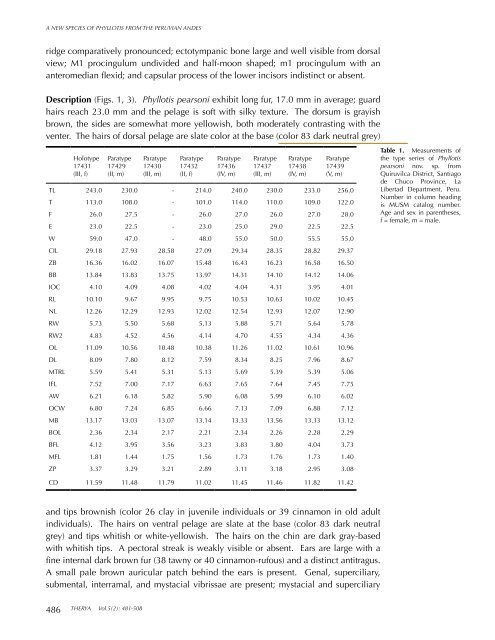therya-5_2
therya-5_2
therya-5_2
You also want an ePaper? Increase the reach of your titles
YUMPU automatically turns print PDFs into web optimized ePapers that Google loves.
A NEW SPECIES OF PHYLLOTIS FROM THE PERUVIAN ANDES<br />
ridge comparatively pronounced; ectotympanic bone large and well visible from dorsal<br />
view; M1 procingulum undivided and half-moon shaped; m1 procingulum with an<br />
anteromedian flexid; and capsular process of the lower incisors indistinct or absent.<br />
Description (Figs. 1, 3). Phyllotis pearsoni exhibit long fur, 17.0 mm in average; guard<br />
hairs reach 23.0 mm and the pelage is soft with silky texture. The dorsum is grayish<br />
brown, the sides are somewhat more yellowish, both moderately contrasting with the<br />
venter. The hairs of dorsal pelage are slate color at the base (color 83 dark neutral grey)<br />
Holotype<br />
17431<br />
(III, f)<br />
Paratype<br />
17429<br />
(II, m)<br />
Paratype<br />
17430<br />
(III, m)<br />
Paratype<br />
17432<br />
(II, f)<br />
Paratype<br />
17436<br />
(IV, m)<br />
Paratype<br />
17437<br />
(III, m)<br />
Paratype<br />
17438<br />
(IV, m)<br />
Paratype<br />
17439<br />
(V, m)<br />
TL 243.0 230.0 - 214.0 240.0 230.0 233.0 256.0<br />
T 113.0 108.0 - 101.0 114.0 110.0 109.0 122.0<br />
F 26.0 27.5 - 26.0 27.0 26.0 27.0 28.0<br />
E 23.0 22.5 - 23.0 25.0 29.0 22.5 22.5<br />
W 59.0 47.0 - 48.0 55.0 50.0 55.5 55.0<br />
CIL 29.18 27.93 28.58 27.09 29.34 28.35 28.82 29.37<br />
ZB 16.36 16.02 16.07 15.48 16.43 16.23 16.58 16.50<br />
BB 13.84 13.83 13.75 13.97 14.31 14.10 14.12 14.06<br />
IOC 4.10 4.09 4.08 4.02 4.04 4.31 3.95 4.01<br />
RL 10.10 9.67 9.95 9.75 10.53 10.63 10.02 10.45<br />
NL 12.26 12.29 12.93 12.02 12.54 12.93 12.07 12.90<br />
RW 5.73 5.50 5.68 5.13 5.88 5.71 5.64 5.78<br />
RW2 4.83 4.52 4.56 4.14 4.70 4.55 4.34 4.36<br />
OL 11.09 10.56 10.48 10.38 11.26 11.02 10.61 10.96<br />
DL 8.09 7.80 8.12 7.59 8.34 8.25 7.96 8.67<br />
MTRL 5.59 5.41 5.31 5.13 5.69 5.39 5.39 5.06<br />
IFL 7.52 7.00 7.17 6.63 7.65 7.64 7.45 7.75<br />
AW 6.21 6.18 5.82 5.90 6.08 5.99 6.10 6.02<br />
OCW 6.80 7.24 6.85 6.66 7.13 7.09 6.88 7.12<br />
MB 13.17 13.03 13.07 13.14 13.33 13.56 13.33 13.12<br />
BOL 2.36 2.34 2.17 2.21 2.34 2.26 2.28 2.29<br />
BFL 4.12 3.95 3.56 3.23 3.83 3.80 4.04 3.73<br />
MFL 1.81 1.44 1.75 1.56 1.73 1.76 1.73 1.40<br />
ZP 3.37 3.29 3.21 2.89 3.11 3.18 2.95 3.08<br />
Table 1. Measurements of<br />
the type series of Phyllotis<br />
pearsoni nov. sp. from<br />
Quiruvilca District, Santiago<br />
de Chuco Province, La<br />
Libertad Department, Peru.<br />
Number in column heading<br />
is MUSM catalog number.<br />
Age and sex in parentheses,<br />
f = female, m = male.<br />
CD 11.59 11.48 11.79 11.02 11.45 11.46 11.82 11.42<br />
and tips brownish (color 26 clay in juvenile individuals or 39 cinnamon in old adult<br />
individuals). The hairs on ventral pelage are slate at the base (color 83 dark neutral<br />
grey) and tips whitish or white-yellowish. The hairs on the chin are dark gray-based<br />
with whitish tips. A pectoral streak is weakly visible or absent. Ears are large with a<br />
fine internal dark brown fur (38 tawny or 40 cinnamon-rufous) and a distinct antitragus.<br />
A small pale brown auricular patch behind the ears is present. Genal, superciliary,<br />
submental, interramal, and mystacial vibrissae are present; mystacial and superciliary<br />
486<br />
THERYA Vol.5(2): 481-508



